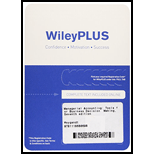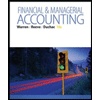
a)
Activity Based Costing: Activity Based Costing refers to the allocation of the factory
Overhead: Overhead refers to the costs, which are utilized in business activities, however cannot be related to a specific activity or product.
To Assign: The overhead cost per unit for products, using activity-based costing.
b)
Activity Based Costing: Activity Based Costing refers to the allocation of the factory overheads when there are numerous products and processes. Activity based costing aims at assigning the costs among the products in a proportionate way. Activity Based Costing has four levels of activity.
To Compute: The cost per unit and gross profit of each model using Activity-based costing.
c)
Traditional Product Costing: Accounting process to determine the total cost incurred to manufacture a product on the basis of volume metric is known as traditional product costing.
Activity Based Costing: Activity Based Costing refers to the allocation of the factory overheads when there are numerous products and processes. Activity based costing aims at assigning the costs among the products in a proportionate way. Activity Based Costing has four levels of activity.
To Explain: The future plan for the management of Company SE to be more profitable.
Want to see the full answer?
Check out a sample textbook solution
Chapter 4 Solutions
Managerial Accounting: Tools For Business Decision Making, Seventh Edition Wileyplus Card
- Solve thisarrow_forwardWhat is the amount of net fixed assets?arrow_forwardRamsey Corp. reported the following balances at the end of the year: Credit Sales: $275,000 Accounts Receivable: $68,000 Allowance for Uncollectible Accounts before adjustment: $2,800 debit Ramsey Corp. estimates that 7.5% of the credit sales are uncollectible. After the year-end adjustment, what is the Net Realizable Value of Accounts Receivable?arrow_forward
- What would be the operating income if the company sells 4,000 units in a year of this general accounting question?arrow_forward6 points general accounting questionarrow_forwardLast year, the House of Pink had sales of $736,750, net operating income of $61,000, and operating assets of $95,000 at the beginning of the year and $80,000 at the end of the year. What was the company's turnover? (Provide answer to this financial accounting Problem)arrow_forward
 Managerial AccountingAccountingISBN:9781337912020Author:Carl Warren, Ph.d. Cma William B. TaylerPublisher:South-Western College Pub
Managerial AccountingAccountingISBN:9781337912020Author:Carl Warren, Ph.d. Cma William B. TaylerPublisher:South-Western College Pub Financial & Managerial AccountingAccountingISBN:9781285866307Author:Carl Warren, James M. Reeve, Jonathan DuchacPublisher:Cengage Learning
Financial & Managerial AccountingAccountingISBN:9781285866307Author:Carl Warren, James M. Reeve, Jonathan DuchacPublisher:Cengage Learning Cornerstones of Cost Management (Cornerstones Ser...AccountingISBN:9781305970663Author:Don R. Hansen, Maryanne M. MowenPublisher:Cengage Learning
Cornerstones of Cost Management (Cornerstones Ser...AccountingISBN:9781305970663Author:Don R. Hansen, Maryanne M. MowenPublisher:Cengage Learning- Principles of Accounting Volume 2AccountingISBN:9781947172609Author:OpenStaxPublisher:OpenStax College



